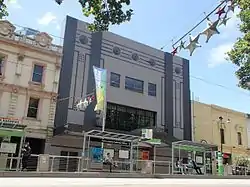Palace Theatre, Melbourne
The Palace Theatre (also known as The Palace) was an entertainment venue located in Melbourne, Australia. First built for live theatre in 1912, it was also used as a cinema and for live music. It was demolished except for its facade in 2020 after much community opposition, to be replaced by a hotel.[1]
 | |
 | |
| Former names | Metro Nightclub Palace Theatre Metro Theatre St James Theatre Apollo Theatre Brennan's Amphitheatre |
|---|---|
| Location | 20-30 Bourke Street, Melbourne, Australia |
| Capacity | 1855 |
| Opened | April 1912 |
| Closed | May 2014 |
History
The Palace site had a rich history of entertainment uses through many many different incarnations over the decades 1912-2010s. Although altered many times, its superabundance of contributions to Melbourne's theatrical heritage made it worthy of preservation, arguments which unfortunately did not prevent its destruction.
Excelsior Hotel

The plot of land on 20-30 Bourke Street was occupied from the late 1850s Excelsior Hotel. The association between hotels and theatres at the time was close, and the hotel incorporated a hall (known as the Queen's Hall) used for vaudeville performances and other entertainment including boxing and wrestling. The hotel later became known as Stutt's Hotel circa 1875, and then the Hotel Douglas in 1900. The last listing for the Hotel Douglas in the Sands Directory was in 1911, after this the hotel burned to the ground. The land was sold for £32,000.
Theatre

In 1911 the Queensland based architects Eaton & Bates, in association with the Melbourne architect Nahum Barnet, were commissioned to design a new theatre for the site for James Brennan. The design had seating on three levels and a large proscenium with curtains of gold. The front section included some rooms on the upper floors known as the Pastoral Hotel.[2] It opened in April 1912 as Brennans Amphitheater.
In 1916 the Sydney architect Henry Eli White designed alterations, which involved a complete refitting of the auditorium and lobby with the addition of ornate plaster decoration in a Louis Seize style, and it was renamed the Palace Theatre. Between 1919 and c. 1922 a front room on the upper level was let for use as a studio to the prominent artists Arthur Streeton and Max Meldrum.[2] "Palace Chambers", which was similarly located and perhaps the same space, was used by the Institute of Arts and Literature[3] between 1921 and 1927.
In 1923 the auditorium was extensively remodelled, though retaining the Louis Seize style, overlaid with Adamesque decoration, and it was re-opened as The New Palace.[4]
Cinema
In 1934 further alterations were carried out and from then on it was known as the Apollo Theatre. The life of the Apollo was short lived, as 6 years later in 1940 the building was renamed the St James. In 1951 it was purchased by MGM, was renamed the 'St James Theatre & Metro', featuring films exclusively from its owners. The facade was substantially remodelled in an Art Deco style designed by H Vivian Taylor, the only part which still remains today. Internally the proscenium was replaced and the side boxes and the balcony ends were removed to allow installation of a CinemaScope screen.[4] The last film to be shown at the MGM cinema was Kelly's Heroes, starring Clint Eastwood in October 1970. After this it was sold.
Theatre
The cinema was reopened as a theatre in 1971. It featured a 39-week season of the musical Hair from 1971 to 1972. The life of the theatre was short-lived, as in 1974 it was converted back into a cinema and renamed the Palace Theatre for the first time since 1916.
Church
In 1980 the cinema was sold to the Melbourne Revival Centre, a Pentecostal church headquartered in Melbourne. It became a major venue for their services, which involved theatre productions.[4]
Night Club

The next sale resulted in a major refurbishment by the Melbourne architectural firm Biltmoderne. In 1987 the building was transformed into the Metro Nightclub.[2] The Metro was described in 2006 as having a "classy, intimate VIP lounge in Gods Bar along with the funky Fish Bowl on the mezzanine level providing electrifying views of the Main Room below, all available for your partying pleasure."[5]
Music venue

In 2007 the Metro nightclub was sold. The new owners, who operated the former Palace, St Kilda, lost an acrimonious 2-year battle with the State Government over the lease of the old building and moved their business to the Metro. They undertook works to convert the Metro into a live music venue, and changed its name to The Palace. The old Palace in St Kilda mysteriously burned down only a few months later under suspicious circumstances.[6]
Over the next 7 years it became a very well established venue, hosting acts such as George Clinton, The Black Keys, Queens of the Stone Age, Arctic Monkeys and The Killers, to name a few.[7] It had a capacity of 1850.
Closure, Controversy and Demolition

In late 2012 The Palace was sold to a China-based developer Jinshan Investment Group for $11.2 million. In mid 2013 the new owners revealed plans for a major 30-storey W Hotel development replacing the theatre, worth $180 million.[8] These plans generated considerable opposition, especially from Melbourne's music community.[9] The City of Melbourne also opposed the plans since it was far in excess of the height limit on the site. The plans were then modified into a smaller 7-storey hotel. The theatre was then closed in April 2014.

In late 2014, while the City of Melbourne was considering heritage protection of the interior (which would have been the first interior listed by them), a skip in a rear lane was discovered full of broken pieces of the interior decorative plaster and tiles, and jackhammering sounds were coming from inside. Activists claimed that owners Jinshan Investments were deliberately destroying the interior features to prevent any heritage listing.[10][8]
In response, Jinshan representatives stated that "over the past 100 years [The Palace] has been dramatically altered, with much of its original features and history stripped by previous owners, including the Metro Nightclub which added steel staircases and galleries that dramatically transformed the interior in the 1980s."[11]
The subsequent recommendation to Council was that not enough remained to justify listing the interior.
The City of Melbourne nevertheless refused to issue a permit for the hotel, a decision that the owners appealed to the Victorian Civil and Administrative Tribunal (VCAT) in early 2016. However, the decision handed down a few months later was to allow demolition and redevelopment works to go ahead.[12] In late February 2020 internal demolition works began, leaving only the external walls.[13]
In popular culture
In 1956, the Palace Theatre helped to inspire an enduring Olympic tradition, when a teenager named John Ian Wing wrote a letter to the organisers of the Melbourne Olympics, suggesting that the Closing Ceremony feature the athletes of all nations entering the stadium as an intermingled group. The idea was adopted, and helped to redeem the Melbourne Games' reputation as the 'Friendly Games'.[14] Wing has since written that his idea was inspired by his observation of the jumbled and spirited crowds exiting the Palace Theatre, visible from his home above a Bourke Street restaurant.[15][16]
In 1976, cover band The Blue Echoes used a photograph of Bourke Street for the album cover for their album 'Dancing in the Street'. The Palace can clearly been seen on the photograph.
References
- Palace devotees step up campaign to save venue, The Age, 11 October 2013
- Assessment of Cultural Heritage Significance, Heritage Victoria, November 2013
- "Gossip from Melbourne". The Sunday Times (Sydney). No. 1888. New South Wales, Australia. 2 April 1922. p. 23. Retrieved 28 September 2022 – via National Library of Australia.
- Heritage Appraisal, Palace Theatre, Lovell Chen, June 2013
- "Metro Nightclub Melbourne". Retrieved 19 October 2015.
- Palace sold for $13mill, Australian Financial Review,30 August 2012
- "Melbourne's Palace Theatre falls silent for the last time". Australian Broadcasting Corporation. Retrieved 20 October 2015.
- "Palace Theatre Enters Last Chance Saloon As The Bulldozers Warm Up". 5 December 2014. Retrieved 19 October 2015.
- Jones, Nicholas (5 July 2013). "Plan For Melbourne's Palace Theatre To Be Demolished For Luxury Apartments". Tone Deaf. Retrieved 22 February 2020.
- "Outrage as workers begin ripping out Palace interior before Council Heritage Decision". 20 November 2014. Retrieved 15 May 2016.
- "Jinshan Investments defends stripping of Palace Theatre Venue". 21 November 2014. Retrieved 15 May 2016.
- "Palace Theatre to Be Demolished". 22 April 2016. Retrieved 15 November 2016.
- Fowler, Michael (21 February 2020). "'Morally outrageous': After 108 years, demolition of The Metro begins". The Age. Retrieved 22 February 2020.
- Button, James (11 November 2006). "Ceremony born from Wing and a prayer". The Age.
- Wing, John Ian. "History of the Olympic Closing Ceremony". Retrieved 4 December 2014.
At the time, I was living above my father's restaurant at 16 Bourke Street Melbourne, which was two doors away from St James picture theatre. It was now about 11.00pm. A few hours earlier, looking down into the street, I watched people lining up in an orderly manner waiting to go into the theatre. Now I watched them come out in one big mass, spilling out onto the road and stopping the traffic. They were smiling and laughing and even talking to strangers as if they had known each other before. Then the 'idea' came to me. As I was writing my letter to the chairman of the Organising Committee, I suggested that all the athletes of the world should come together for the closing ceremony, to unite and intermingle and enter the Stadium as One Nation.
- Culpepper, Chuck (23 August 2008). "His big idea had legs". Los Angeles Times.